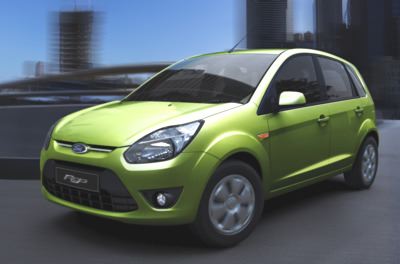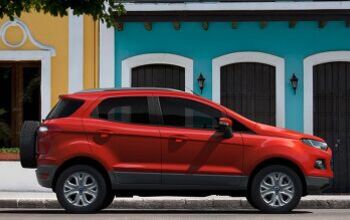One Ford? "All New" Figo Launches in India

Sales recently began in India for Ford’s “all new” Figo. The launch of the Figo, a five-door sedan/hatchback, was a supposed to be a big deal. It is Ford’s first car designed specifically for the Indian market, and it was introduced by Mullaly himself in India last September. It’s built in Ford’s refurbished Chennai plant, where production started up in early February after a $500 million investment. In addition to producing cars for the local market, where sales are booming and compact cars, the so-called Sub B segment, make up 70% of the sales volume, Ford intends for the Chennai plant to be a supply hub for their Asia, Pacific and Africa operations.
Since arriving in Dearborn with a mandate for change, Ford’s CEO Alan Mullaly has been the primary cheerleader for the automaker’s One Ford program. The 2011 Focus, introduced at the NAIAS in Detroit earlier this year, will be the essentially the same car across global markets. The automaker wants to avoid past errors like building a uniquely inferior version of the previous generation Focus for America. The goal is to reduce costs, and focus all of the company’s global resources behind a single product. When Ford reintroduces the subcompact Fiesta to the US, it also will be nearly the same car as the EU version, introduced a couple years ago.
It is interesting that while Ford is launching the truly all-new Fiesta for the US and European markets, One Ford takes a back seat to financial realities of selling cars in developing countries. While Ford says that the Figo “leverages Ford’s small-car platform architecture, sharing underlying technology with the Ford Fiesta,” in another press release the Dearborn automaker says, “Designed and engineered for the India and export, the new Figo is based on a proven global small car architecture.”
Proven global small car architecture? What this means is that developing countries still get leftovers and old technology. The “all-new” Figo, is really the last generation Fiesta with new sheet metal to conform to Ford’s current “kinetic” design language.
Though the Indian auto market is booming, with record sales in February, it’s still very price sensitive. The least expensive Figo will carry a sticker price of about $7,600 for the 1.2 liter gasoline powered version, rising to $11,660 fully equipped, with a 1.4 liter diesel motor. The new 2011 US spec Fiesta has an MSRP starting at $13,320. Do the math.
Car companies have used aging veterans for their secondary markets for a long time, as recent TTAC articles about Brazilian VW Beetles and Buses will demonstrate. The Jeep XJ Cherokee is still, I believe, in production in China as the XJ2500. The idea, I suppose, is that developing markets have less sophisticated and less demanding consumers. As the Tata Nano demonstrates, when someone is moving from a scooter to an actual car, you don’t necessarily need GPS and electric mirrors standard to sell him on the car.
Leveraging global resources and producing a uniform global product isn’t the only way to save costs. Making the same Fiesta for Europe and North America will cut costs, no doubt, but the investment in the tooling for the new Fiesta will not be recovered for a while. It may not be possible, at this time, to make a profit on the Gen VI car at competitive Indian prices. Meanwhile the tooling for the Gen V Fiesta has already been paid for.
Fortunately, Indians most likely won’t have to wait that long to have access to the latest Fiesta. Ford has said that it intends to announce new product for the Indian market every 12 to 18 months for the foreseeable future. This has led to speculation that Ford may follow the Figo with the new three door Fiesta hatchback. Those rumors, though, peg the price at just around 600,000 rupees, at today’s conversion rate, $13,162, within a couple hundred dollars of the US spec Fiesta’s MSRP. Like I said, do the math.

Ronnie Schreiber edits Cars In Depth, the original 3D car site.
More by Ronnie Schreiber
Latest Car Reviews
Read moreLatest Product Reviews
Read moreRecent Comments
- FreedMike If Dodge were smart - and I don't think they are - they'd spend their money refreshing and reworking the Durango (which I think is entering model year 3,221), versus going down the same "stuff 'em full of motor and give 'em cool new paint options" path. That's the approach they used with the Charger and Challenger, and both those models are dead. The Durango is still a strong product in a strong market; why not keep it fresher?
- Bill Wade I was driving a new Subaru a few weeks ago on I-10 near Tucson and it suddenly decided to slam on the brakes from a tumbleweed blowing across the highway. I just about had a heart attack while it nearly threw my mom through the windshield and dumped our grocery bags all over the place. It seems like a bad idea to me, the tech isn't ready.
- FreedMike I don't get the business case for these plug-in hybrid Jeep off roaders. They're a LOT more expensive (almost fourteen grand for the four-door Wrangler) and still get lousy MPG. They're certainly quick, but the last thing the Wrangler - one of the most obtuse-handling vehicles you can buy - needs is MOOOAAAARRRR POWER. In my neck of the woods, where off-road vehicles are big, the only 4Xe models I see of the wrangler wear fleet (rental) plates. What's the point? Wrangler sales have taken a massive plunge the last few years - why doesn't Jeep focus on affordability and value versus tech that only a very small part of its' buyer base would appreciate?
- Bill Wade I think about my dealer who was clueless about uConnect updates and still can't fix station presets disappearing and the manufacturers want me to trust them and their dealers to address any self driving concerns when they can't fix a simple radio?Right.
- FreedMike I don't think they work very well, so yeah...I'm afraid of them. And as many have pointed out, human drivers tend to be so bad that they are also worthy of being feared; that's true, but if that's the case, why add one more layer of bad drivers into the mix?


































Comments
Join the conversation
That's some pretty subtle "new sheet metal" there! Aside from the tweaked headlights and front bumper that looks almost exactly like the old Euro market Mark V Fiesta. There's maybe a slightly different crease in the doors but essentially that's the car Ford launched here in 2002 recycled for India... so much for "one Ford" As niky and others point out maybe this is no bad thing - Proven platforms are probably better suited to developing markets since they're cheaper and more robust. It's just a bit of a cheek from Ford to be touting the Figo as "all new" and "designed specifically for the Indian market" when it patently isn't
Down here there's a large group that controls a lot of Ford and Hyundai dealerships all over the country that has bought all the myriad (stamping, etc.) equipment needed to make the old Hyundai Tucson a "genuine" Brazilian product. Hyundai has helped them out leaving the Tucson moniker out of the new ix35 (?) coming as an imported car in the next few months. The old-new Tucson will sell in the 30k USD range while the new new Tucson ix 35 will reportedly be sold at 45k USD. Well, I think they'll never sell in the numbers the current Tucson sells. But they'll sell. And in numbers that'll make their owners richer. But they'll never dominate the segment they're in unlike dedicated local projects (Ford Ecosport) or imports that kill local on price X equipment (Hyundai i30 as of late). This One car thing has been around since the 80s. And it doesn't work. What works is when you get a thing like the Fiat Palio, developed on a Fiat Uno's platform, but in such a way that reallly attends to local markets needs. Or the Vw Gol that derives from the first few Golfs and passats but has been continuously been developed for local conditions. These sell. This Figo, which we'll get, will further send the Fiesta into also ran territory in Brazil. When it gets here its old elsewhere. And it's not specifically designed to attend to local needs. So Ford will still be the 4th or 5th option of anyone buying in Brazil's largest market segment (at least 70% if hatches and their derived sedans, SWs, minvans and pick ups are included).